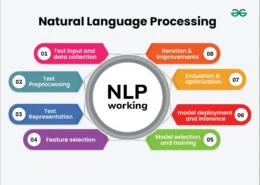Natural Language Processing (NLP) is a subfield of artificial intelligence (AI) focused on enabling computers to understand, interpret, and generate human language. Key Components of NLP: Text Processing: Tokenization: Breaking text into smaller units, like words or sentences. Lemmatization/StemmingRead more
Natural Language Processing (NLP) is a subfield of artificial intelligence (AI) focused on enabling computers to understand, interpret, and generate human language.
Key Components of NLP:
- Text Processing:
- Tokenization: Breaking text into smaller units, like words or sentences.
- Lemmatization/Stemming: Reducing words to their base or root forms.
- Syntax Analysis:
- Parsing: Analyzing the grammatical structure of sentences.
- Part-of-Speech Tagging: Identifying parts of speech (nouns, verbs, adjectives, etc.) in text.
- Semantics:
- Named Entity Recognition (NER): Identifying entities like names, dates, and places.
- Word Sense Disambiguation: Determining word meaning based on context.
- Pragmatics:
- Understanding context and intended meaning, including implied or indirect meanings.
Applications of NLP:
- Machine Translation: Translating text between languages (e.g., Google Translate).
- Sentiment Analysis: Determining the emotional tone of text (e.g., analyzing social media posts).
- Chatbots and Virtual Assistants: Enabling conversational agents like Siri and Alexa to interact in natural language.
- Information Retrieval: Enhancing search engines for accurate query responses.
- Text Summarization: Automatically generating concise summaries of larger texts.
- Speech Recognition: Converting spoken language into text.
Challenges in NLP:
- Ambiguity: Words and sentences can have multiple meanings.
- Context Understanding: Capturing the context in which words are used.
- Cultural and Linguistic Variations: Handling different languages and dialects.
NLP is rapidly evolving, significantly advancing AI and transforming human-machine interaction. It encompasses a range of techniques and applications that make human language accessible to computers, improving tasks from translation and sentiment analysis to virtual assistance and information retrieval.
See less


SQL injection is a type of web application security vulnerability that allows an attacker to inject malicious SQL code into a web application's database in order to extract or modify sensitive data. This is typically done by inserting malicious input into a web form or URL, which is then processed bRead more
SQL injection is a type of web application security vulnerability that allows an attacker to inject malicious SQL code into a web application’s database in order to extract or modify sensitive data. This is typically done by inserting malicious input into a web form or URL, which is then processed by the application’s database.
See lessWhen a web application uses user-input data to construct SQL queries, an attacker can inject malicious SQL code as part of the input. If the application does not properly sanitize or validate the input, the malicious code can be executed by the database, allowing the attacker to access or modify sensitive data.
SQL injection attacks can be used to extract sensitive data, such as passwords or credit card numbers, or to modify data, such as inserting or deleting records. In some cases, an attacker may even be able to gain administrative access to the database or entire system.
SQL injection attacks can be prevented by using prepared statements, input validation, and escaping special characters to ensure that user-input data is not executed as SQL code. Regular security testing and code reviews can also help identify and fix vulnerabilities before they can be exploited.